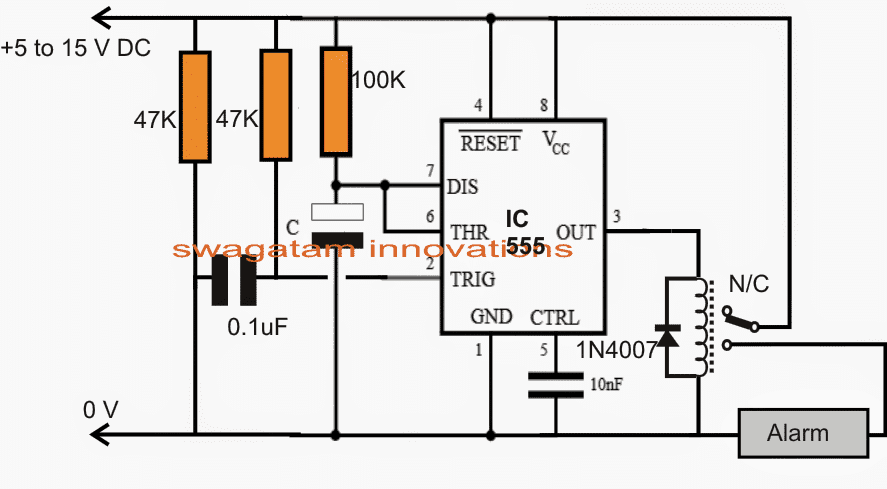In this post I have explained a simple monostable based power switch ON alarm circuit which automatically switches OFF after an adjustable preset delay. The idea was requested by Mr. Will Boswell.
Technical Specifications
Hi there, my name is Will Boswell. I am currently working on a project that involves adding an alarm sounder to an existing circuit, I shall try and explain as best possible.
The existing system is a warning light system whereby when the high voltage kit that I use is turned on, red beacon lights flash in order to warn those inside and outside of the testing area. These lights operate at 24V.
I would like to put a sounder in that sounds for 5 - 10 seconds when the system is turned on, in addition to the lights.
I was rather hoping that I would be able to just piggyback off of one of these lights for my supply but after my own research I have begun to get rather lost and it is a few years since I was at college!
So in a short summary, I am looking for some assistance in regards to having an alarm sound for 5 - 10 seconds every time the system is turned on / lights are activate.
Please any questions, just ask!
Many Thanks in advance
The Design
The requested power switch ON alarm circuit using a delay OFF circuit may be witnessed in the given diagram.
It's basically built around a standard IC 555 monostable multivibrator configuration. The operations are rather simple:
When power is switched on across the circuit, the 0.1uF capacitor momentarily grounds pin2 of the IC, sending an instantaneous triggering signal to the 555 monostable.
This immediately prompts the output of the IC to go high causing a toggling voltage to be activated for the attached relay.
The relay switches ON itself and the alarm unit connected with its N/O and the pole.
The alarm begins buzzing only until the relay shuts off automatically due to the featured monostable one shot characteristic of the IC 555.
The ON period of the relay or the IC output is determined by the values of the 100kresistor and caapcitor C. Different values for C may be tried in between 10uF and 100uF for achieving the closest possible duration of 5 to 10 seconds.
Circuit Diagram


Hi Swagatham…greetings
Can i incorperate the above to water level indicator circuit with 4049 ic output stage?
Hi Dr, Sison, you can use this circuit with your water level indicator outputs, but how will you integrate the 4049 outputs with this circuit?? You will need to add a BC547 transistor with this circuit for it to work.
Hi there does this circuit: https://www.homemade-circuits.com/power-switch-on-alarm-with-auto-off/ reset when power is removed?
Awesome website!!
Thanks Theuns, yes the circuit will reset each time power is switched OFF
Thank you for getting back to me. Forgive my ignorance as I am a mechanical guy, but I have built this circuit and can’t get it to work. Must the 0.1uf capacitor be of the ceramic type or can electrolytic also work? And capacitor C – can it be made bigger to achieve 30sec to 1 minute time?
The capacitor can be any type…however please try with a higher value such as a 1uF or a 4.7uF, or a 10uF….the lead which is going to the ground line should be the negative lead of the capacitor…please try this your circuit will surely start working….if still not let me know…
the values of C and the 100k can be dimesioned as preferred by you for getting longer start ON delays.
Thanks Swagatam – I finally got to this circuit today: it works well. Thanks again for an excellent website!!
You are welcome Theuns, I am glad you coold make it successfully….
i like this web
Dear sir
I am Making a project. Wich is like Cable card At the card there will write Happy New Year
The Card will Go each side to another Side
I Want a Circuit wich can change Polarity after 1 minute
I have already answered your question with appropriate links, please check your previous comments.
I luv this site
thanks!
Thanks for your quick reply. Sir, I already completed this circuit.in this circuit not having phase revers protection and no low , high voltage protection.pls help me.
Mail: aprssuresh@gmail.com
If possible… I'll try to design them and publish in this blog soon.
Sir,
Im using three phase motor, some time one phase fail. I want three phase preventer with time delay out put and phase revers , low voltage, high voltage detector. Please help me.
Mail ID: aprssuresh@gmail.com
Regards
Suresh
Suresh, you can try the following circuit which is a single phase preventer circuit only, without high, low cut off….make this first if it works as per the requirement, we can later on add the high/low cut off in it.
easy-electronic-circuits.blogspot.in/2013/08/simplest-single-phase-preventor-circuit.html